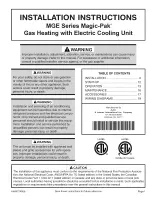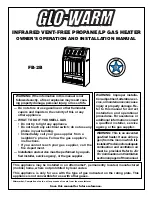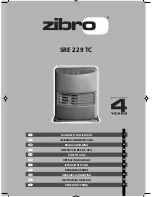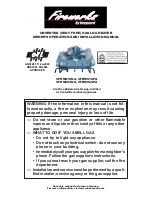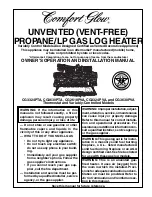
LP-314 Rev. 012 Rel. 003 Date 9.27.19
15
H. Hydronic Heating Module Piping
The hydronic heating module comes pre-plumbed and connected
directly to the storage tank. The heated water inside the tank will
be circulated through one side of the brazed plate heat exchanger
while the heating system water flows through the other side. The
heating system piping is connected to the return and supply pipes
located on the top of the hydronic heating module (see Figure 5).
Piping of the module to the system is not complex and does not
require any of the primary or secondary piping normally used on
high efficiency low mass boilers.
NOTE:
Do not connect hydronic heating module to air handler units.
This module may not be applied to air handler applications.
I. Pressure Relief Valve for the Hydronic System
The pressure relief valve supplied with the appliance is designed to
relieve pressure greater than 30 psi. The hydronic heating module is
designed to withstand pressure up to 150 psi. If you are changing the
pressure relief valve for a higher pressure rating, you must make sure
that the system components are designed for the higher pressure.
The relief valve must be rated for the 135,000 Btu maximum capacity
of the brazed plate heat exchanger. Pipe the discharge line in copper
piping to a drain. Provide 6” clearance from the floor drain.
J. Hydronic Expansion Tank and Make-Up Water
Ensure that the expansion tank is sized to the system volume, brazed
plate capacity, and related piping for the hydronic heating module.
The capacity of the module and brazed plate is ½ gallon. Most
chilled water systems are piped using a closed type expansion tank.
Connect the expansion tank to the air separator only if the separator
is on the suction side of the circulator. The hydronic heating module
has a water line connection of ½” NPT to connect into the pressure
reducing valve and back flow preventer. Normal system pressure is
15 psi.
K. Hydronic Heating Module System Piping
The hydronic heating module is designed to function in a closed loop
hydronic system. The included temperature and pressure gauge
allows the user to monitor the system pressure and temperature
from the hydronic heating module. The gauge should be installed on
the supply outlet piping from the heating module. The installation
of an air elimination device will remove air from the system which
is necessary to avoid an air lock in the central heating circulator. It
is recommended that all the piping is insulated to improve on the
system’s overall efficiency. In the system piping, heating coils in air
handler, flow control valves, or other devices must be installed to
prevent gravity circulation of heated water from the heating module.
Freeze protection for new or existing systems must be composed
of glycol that is specifically formulated to include inhibitors that will
prevent the glycol from attacking the metallic system components.
Make certain that the system fluid is checked for the correct glycol
concentration and inhibitor level. The system should be tested at
least once a year or as recommended by the producer of the glycol
solution. Allowance should be made for the expansion of the glycol
solution in the system piping. Example: 50% by volume glycol
solution expands 4.8% in volume for the temperature increase from
32
o
F to 180
o
F, while water expands 3% with the same temperature
rise.
Listed below are the basic steps that will help guide you through the
installation of the hydronic heating module to the system piping.
1. Connect the system return marked “Return”.
2. Connect the system supply marked “Supply”.
3. Install a balance and purge valve (or shut off drain valve) on the
system return to purge air out of the zone at start-up.
4. Install a back flow preventer on the cold feed make–up water line.
5. Install a pressure reducing valve on the cold feed make up water
line (15 psi operating pressure). Check temperature and pressure
gauge when operating. It should read minimum pressure of 15 psi.
Do not thread a cap or plug into the relief valve or relief valve line
under any circumstances! Explosion and property damage, serious
injury, or death may result.
6. Install the system circulator as shown in the piping details in this
section. Make sure the circulator is properly sized for the system and
friction loss.
7. Install an expansion tank on the system supply. Consult the
expansion tank manufacturer’s instructions for specific information
related to expansion for the required system volume and capacity.
8. Install an air elimination device on the system supply.
9. Install a drain valve at the lowest point of system to blow out the
system if needed. NOTE: The hydronic heating module cannot be
drained completely of water without purging the unit with an air
pressure greater than 15 psi but not exceeding 40 psi. If winterizing
the unit it is recommended, use glycol on the closed loop hydronic
side only.
10. The relief valve is installed at the factory. A pipe discharge line
should be installed to release 6” above a drain, so discharge will be
visible when pressure is relieved. The pipe size must be the same size
as the relief valve outlet.
Figure 5 - Hydronic Heating Module
L. Hydronic Heating Module Output
Hydronic heating module output is based on the burner input and the
flow rate supplied by the selected system circulator through the closed
loop side of the brazed plate exchanger. Included in this section are
graphs that will help you size the appropriate circulator and output
needed to meet your system design requirements. Below is an example
on the steps needed to determine the correct circulator for the system.
Example: System design requires 120,000 Btu at 20 Delta
Step 1
Using the graphs, select the input rate of the appliance. In this example,
we would have to select a minimum input of 199K (the 130K max.
output is 100,000 Btu, which falls below our operating point).
Step 2
Next, go to the chart for the 199K burner input and select the point of
operation where the Btu and Delta T line intersect. Mark the point on
the chart and go to bottom of the chart to determine flow rate needed
to achieve the rated output from the module. This example is 12 GPM.


































